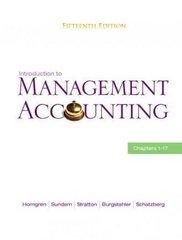Answered step by step
Verified Expert Solution
Question
1 Approved Answer
I need assistance in completing the attached by 11:00PM today. Practical Analysis 1. Calculate the present value given the following information: future value = $1,000;
I need assistance in completing the attached by 11:00PM today.
 Practical Analysis 1. Calculate the present value given the following information: future value = $1,000; number of periods = 3; interest rate of 5%. 2. Calculate the present value given the following information: future value = $800; number of periods = 5; interest rate of 10%. 3. Calculate the future value given the following information; present value $500; number of periods = 4; interest rate of 5%. 4. Calculate the present value given the following information; future value = $2,500; number of periods = 2; interest rate of 15%. 5. Calculate the present value of an annuity given the following information: number of periods = 3, interest rate of 6%, and a payment of $200. 6. Calculate the net present value with a required return of 10%, an initial investment of $30,000, and 10 years of payments of $6,000 each. 7. Calculate the net present value with a required return of 8%, an initial investment of $45,000, and cash flows of $12,000, $20,000, $10,000, and $6,000 for years 1 through 4 respectively. 8. Given the following information, a required return of 8%, an initial investment of $45,000 and cash flows of $12,000, $20,000, $10,000 and $6,000 for years 1 through 4 respectively, should the investment be done? 9. Calculate the net present value with a required return of 5%, an initial investment of $45,000, and cash flows of $9,000, $8,000, $15,000, and $20,000 for years 1 through 4 respectively. 10. Given the following information, with a required return of 5%, an initial investment of $45,000, and cash flows of $9,000, $8,000, $15,000, and $20,000 for years 1 through 4 respectively. Is the investment considered to be a good investment? 11. Calculate break-even per unit given the following information: sales per unit of $25, variable costs of $13, fixed costs of $5,000. Remember, you cannot have partial units, so you will need to round up if the answer is decimal. 12. Calculate break-even in dollars given the following information: sales per unit of $40, variable costs of $15, fixed costs of $15,000, and a desired profit of $20,000. Remember, you cannot have partial units, so you will need to round up if the answer is a decimal. 13. Calculate the degree of operating leverage given the following information; sales of $25,000; variable costs of $13,000; and operating income of $7,000 for year one, and sales of $40,000; variable cost $15,000; and operating income of $16,000 for year 2. Your answer should be rounded to two decimal places. (For this problem, specifically calculate the difference between the sales and the operating income for each of the given years. This will allow you to calculate the degree of operating leverage.)
Practical Analysis 1. Calculate the present value given the following information: future value = $1,000; number of periods = 3; interest rate of 5%. 2. Calculate the present value given the following information: future value = $800; number of periods = 5; interest rate of 10%. 3. Calculate the future value given the following information; present value $500; number of periods = 4; interest rate of 5%. 4. Calculate the present value given the following information; future value = $2,500; number of periods = 2; interest rate of 15%. 5. Calculate the present value of an annuity given the following information: number of periods = 3, interest rate of 6%, and a payment of $200. 6. Calculate the net present value with a required return of 10%, an initial investment of $30,000, and 10 years of payments of $6,000 each. 7. Calculate the net present value with a required return of 8%, an initial investment of $45,000, and cash flows of $12,000, $20,000, $10,000, and $6,000 for years 1 through 4 respectively. 8. Given the following information, a required return of 8%, an initial investment of $45,000 and cash flows of $12,000, $20,000, $10,000 and $6,000 for years 1 through 4 respectively, should the investment be done? 9. Calculate the net present value with a required return of 5%, an initial investment of $45,000, and cash flows of $9,000, $8,000, $15,000, and $20,000 for years 1 through 4 respectively. 10. Given the following information, with a required return of 5%, an initial investment of $45,000, and cash flows of $9,000, $8,000, $15,000, and $20,000 for years 1 through 4 respectively. Is the investment considered to be a good investment? 11. Calculate break-even per unit given the following information: sales per unit of $25, variable costs of $13, fixed costs of $5,000. Remember, you cannot have partial units, so you will need to round up if the answer is decimal. 12. Calculate break-even in dollars given the following information: sales per unit of $40, variable costs of $15, fixed costs of $15,000, and a desired profit of $20,000. Remember, you cannot have partial units, so you will need to round up if the answer is a decimal. 13. Calculate the degree of operating leverage given the following information; sales of $25,000; variable costs of $13,000; and operating income of $7,000 for year one, and sales of $40,000; variable cost $15,000; and operating income of $16,000 for year 2. Your answer should be rounded to two decimal places. (For this problem, specifically calculate the difference between the sales and the operating income for each of the given years. This will allow you to calculate the degree of operating leverage.) Step by Step Solution
There are 3 Steps involved in it
Step: 1

Get Instant Access to Expert-Tailored Solutions
See step-by-step solutions with expert insights and AI powered tools for academic success
Step: 2

Step: 3

Ace Your Homework with AI
Get the answers you need in no time with our AI-driven, step-by-step assistance
Get Started


